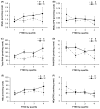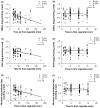Racial differences in the relationship between tobacco dependence and nicotine and carcinogen exposure
- PMID: 22971134
- PMCID: PMC3553231
- DOI: 10.1111/j.1360-0443.2012.04077.x
Racial differences in the relationship between tobacco dependence and nicotine and carcinogen exposure
Abstract
Aims: To investigate the relationships between tobacco dependence, biomarkers of nicotine and carcinogen exposure and biomarkers of nicotine and carcinogen exposure per cigarette in back and white smokers.
Design, setting and participants: A total of 204 healthy black (n = 69) and white (n = 135) smokers were enrolled into two clinical studies.
Measurement: Nicotine equivalents (nicotine and its metabolites), 4-(methylnitrosamino)-1-(3)pyridyl-1-butanol (NNAL) and polycyclic aromatic hydrocarbon (PAH) metabolites were measured in urine. The Fagerström Test for Nicotine Dependence (FTND) and time to first cigarette (TFC) measured tobacco dependence.
Findings: Average TFC and FTND for blacks and whites were not significantly different. Urine NNAL and nicotine equivalents increased with increasing FTND in whites but did not increase in blacks (race × FTND interaction, both P < 0.031). The interaction term was not significant for PAHs. An inverse relationship was seen between FTND and nicotine equivalents, NNAL and PAH metabolites per cigarette in blacks but remained flat in whites (race × FTND interaction, all P ≤ 0.039). Regardless of dependence (low dependence, TFC >15 minutes; high dependence, TFC ≤15 minutes), FTND and TFC were not correlated significantly with urine nicotine equivalents and carcinogen exposure in blacks. We found moderate correlations between FTND and TFC and nicotine equivalents and carcinogen exposure among whites of low dependence and non-significant correlations among whites of high dependence.
Conclusion: In the United States, tobacco dependence measures were related linearly to nicotine intake and carcinogen exposure in white but not in black smokers. The relationship between dependence measures and tobacco biomarkers in black smokers regardless of level of dependence resembled highly dependent white smokers.
© 2012 The Authors, Addiction © 2012 Society for the Study of Addiction.
Conflict of interest statement
NLB serves as a consultant to several pharmaceutical companies that market smoking cessation medications and has served as a paid expert witness in litigation against tobacco companies. Other authors have no conflicts to declare.
Figures


Similar articles
-
Racial differences in the relationship between number of cigarettes smoked and nicotine and carcinogen exposure.Nicotine Tob Res. 2011 Sep;13(9):772-83. doi: 10.1093/ntr/ntr072. Epub 2011 May 5. Nicotine Tob Res. 2011. PMID: 21546441 Free PMC article.
-
Black Light Smokers: How Nicotine Intake and Carcinogen Exposure Differ Across Various Biobehavioral Factors.J Natl Med Assoc. 2019 Oct;111(5):509-520. doi: 10.1016/j.jnma.2019.04.004. Epub 2019 May 11. J Natl Med Assoc. 2019. PMID: 31084916 Free PMC article.
-
Tobacco-specific nitrosamine 4-(methylnitrosamino)-1-(3-pyridyl)-1-butanol (NNAL) in smokers in the United States: NHANES 2007-2008.Biomarkers. 2011 Mar;16(2):112-9. doi: 10.3109/1354750X.2010.533288. Epub 2010 Nov 29. Biomarkers. 2011. PMID: 21114376
-
Urinary tobacco smoke-constituent biomarkers for assessing risk of lung cancer.Cancer Res. 2014 Jan 15;74(2):401-11. doi: 10.1158/0008-5472.CAN-13-3178. Epub 2014 Jan 9. Cancer Res. 2014. PMID: 24408916 Free PMC article. Review.
-
Epidemiology of tobacco carcinogenesis.Curr Oncol Rep. 2000 May;2(3):257-62. doi: 10.1007/s11912-000-0076-y. Curr Oncol Rep. 2000. PMID: 11122851 Review.
Cited by
-
The Influence of Puff Characteristics, Nicotine Dependence, and Rate of Nicotine Metabolism on Daily Nicotine Exposure in African American Smokers.Cancer Epidemiol Biomarkers Prev. 2016 Jun;25(6):936-43. doi: 10.1158/1055-9965.EPI-15-1034. Epub 2016 Mar 30. Cancer Epidemiol Biomarkers Prev. 2016. PMID: 27030603 Free PMC article.
-
Racial disparities in intensity of smoke exposure and nicotine intake among low-dependence smokers.Drug Alcohol Depend. 2021 Apr 1;221:108641. doi: 10.1016/j.drugalcdep.2021.108641. Epub 2021 Feb 18. Drug Alcohol Depend. 2021. PMID: 33652379 Free PMC article. Clinical Trial.
-
Past-year discrimination and cigarette smoking among sexual minority women: investigating racial/ethnic and sexual identity differences.J Behav Med. 2021 Oct;44(5):726-739. doi: 10.1007/s10865-021-00217-x. Epub 2021 Apr 2. J Behav Med. 2021. PMID: 33797683 Free PMC article.
-
Examining racial differences in smoking outcomes among smokers enrolled in an intravenous nicotine infusion study.Addict Behav. 2023 May;140:107615. doi: 10.1016/j.addbeh.2023.107615. Epub 2023 Jan 9. Addict Behav. 2023. PMID: 36640662 Free PMC article.
-
Predictors of the Nicotine Dependence Behavior Time to the First Cigarette in a Multiracial Cohort.Nicotine Tob Res. 2015 Jul;17(7):819-24. doi: 10.1093/ntr/ntu236. Epub 2014 Nov 27. Nicotine Tob Res. 2015. PMID: 25431372 Free PMC article.
References
-
- USDHHS. Tobacco Use Among US Racial/ethnic Minority Groups: African Americans, American Indians and Alaska Natives, Asian Americans, and Pacific Islanders, Hispanics: Executive Summary: a Report of the Surgeon General. U.S. Department of Health and Human Services. Centers for Disease Control and Prevention, National Center for Chronic Disease Prevention and Health Promotion, Office on Smoking and Health; Atlanta, GA: 1998.
-
- Haiman CA, Stram DO, Wilkens LR, Pike MC, Kolonel LN, Henderson BE, et al. Ethnic and racial differences in the smoking-related risk of lung cancer. N Engl J Med. 2006;354(4):333–42. - PubMed
Publication types
MeSH terms
Substances
Grants and funding
LinkOut - more resources
Full Text Sources

